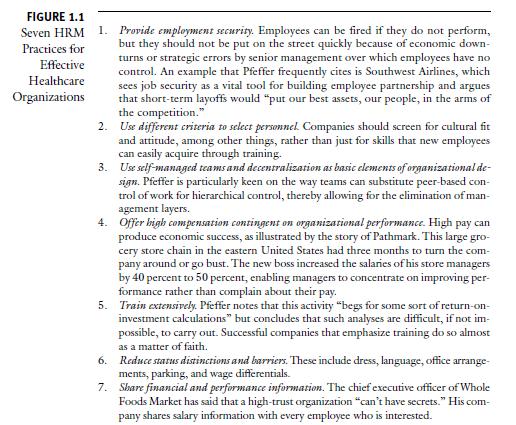Question:
Before class, review the seven HR practices developed by Jeffrey Pfeffer and shown in Figure 1.1. Consider how your current/most recent employer follows any three of these seven practices. Write a 1–2 page summary that lists the three practices you selected and their compatibilities (or incompatibilities) with your employer’s HRM practices.
In class, form a group of four or five students and share your perceptions. Discuss the following:
• What similarities and differences arise among the practices in your organization and those in your group members’ employers?
• Which of the seven practices seem to be least followed by these organizations, and why?
Figure 1.1

Transcribed Image Text:
FIGURE 1.1 Seven HRM Practices for Effective Healthcare Organizations 1. Provide employment security. Employees can be fired if they do not perform, but they should not be put on the street quickly because of economic down- turns or strategic errors by senior management over which employees have no control. An example that Pfeffer frequently cites is Southwest Airlines, which sees job security as a vital tool for building employee partnership and argues that short-term layoffs would "put our best assets, our people, in the arms of the competition." 2. Use different criteria to select personnel. Companies should screen for cultural fit and attitude, among other things, rather than just for skills that new employees can easily acquire through training. 3. Use self-managed teams and decentralization as basic elements of organizational de- sign. Pfeffer is particularly keen on the way teams can substitute peer-based con- trol of work for hierarchical control, thereby allowing for the elimination of man- agement layers. 4. Offer high compensation contingent on organizational performance. High pay can produce economic success, as illustrated by the story of Pathmark. This large gro- cery store chain in the eastern United States had three months to turn the com- pany around or go bust. The new boss increased the salaries of his store managers by 40 percent to 50 percent, enabling managers to concentrate on improving per- formance rather than complain about their pay. 5. Train extensively. Pfeffer notes that this activity "begs for some sort of return-on- investment calculations" but concludes that such analyses are difficult, if not im- possible, to carry out. Successful companies that emphasize training do so almost as a matter of faith. 6. Reduce status distinctions and barriers. These include dress, language, office arrange- ments, parking, and wage differentials. 7. Share financial and performance information. The chief executive officer of Whole Foods Market has said that a high-trust organization "can't have secrets." His com- pany shares salary information with every employee who is interested.








